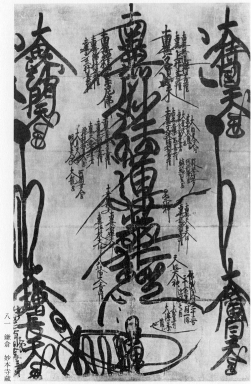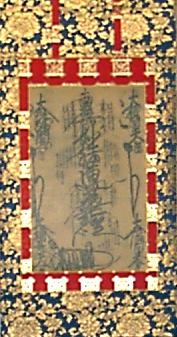The four heavenly kings are the guardians of the world who
reside on the slopes of Mt. Sumeru in the heaven named after them
from whence they are each responsible for one of the four
cardinal directions. Each leads an army of supernatural creatures
who help them keep the fighting demons (asuras) at bay. A
Dictionary of Buddhist Terms and Concepts relates the following information about them:
"The lords of the four quarters who serve Taishaku
as his generals and protect the four continents. They are
said to live halfway down the four sides of Mt. Sumeru. They
are Jikokuten (Skt Dhritarashtra) who protects the
east, Komokuten (Virupaksha) who guards the west,
Bishamonten (Vaishravana) who watches over the north
and Zojoten (Virudhaka) who defends the south. Their
respective functions are to protect the world; to discern and
punish evil and encourage the aspiration for enlightenment;
to listen to the Buddhist teachings and protect the place
where the Buddha expounds them; and to relieve people of
their sufferings. They appear in the ceremony of the Lotus
Sutra with their ten thousand retainer gods, and in the
'Dharani' (twenty-sixth) chapter, Bishamonten and Jikokuten
pledge on behalf of all four to protect those who embrace the sutra." (p.117)
The Flammarion Iconographic Guide: Buddhism states:
"These are the four celestial kings believed to
guard the four cardinal points. Three are vassals of the
fourth, Vaisravana. They are thought to live on Mount Meru,
the home of the 33 deities (Trayastrimsa) and at the
gates of the paradise of Indra, protector of Buddhism.
Acolytes of Avalokitesvara, they are believed by some authors to be hypostases of the four-headed Brahminical deities
symbolizing the cardinal points. They are the protectors of
the world and of the Buddhist Law. As kings of the world,
they were confused with their generals, and the Lalitavistara
describes them already carrying weapons and wearing armor.
Buddhist legends about them are legion: they are said to have
assisted at the birth of the Buddha, and held up the hooves
of his horse when he left the palace of the king his father
at Kapilavastu. They offered the Buddha four bowls of food,
which he miraculously merged into one. They were also present
at his Parinirvana." (p. 241)
Dai Bishamon Tenno
Vaishravana ~ Heavenly King of the North
Vaishravana is one of the Four Heavenly Kings. The Flammarion
Iconographic Guide: Buddhism describes Vaishravana as follows:
"Vaisravana is the guardian of the north and the
chief of the four guardian kings - 'He who is knowing'. 'He
who hears everything in the kingdom', the protector of the
state par excellence, sometimes thought to be a god of
defensive warfare. In China, he is considered to be a
Buddhicization of the Indian god of wealth, Kuvera, the north
being considered to hold fabulous treasures. He presides over
winter and is black, so is also called 'the black warrior'.
His symbols are a jewel and a serpent, and he commands a
large army of Yaksas." (p.242)
Vaishravana's army and attendants consisted of the kimnaras
and the yakshas who are two of the eight kinds of supernatural
beings who are said to revere and protect the Dharma. The
kimnaras are celestial musicians and dancers who have the bodies
of birds and human heads and torsos. They officiate at
Vaishravana's court. The yakshas are a kind of flesh-eating demon
or spirit who make up Vaishravana's army. Originally the yakshas
appeared as the spirits of the trees and forests and even
villages; but they had a fierce side as well, and in their more
demonic aspect came to be called rakshasas. The Flammarion
Iconographic Guide: Buddhism states:
"The Yaksas are commanded by 28 generals, of whom
the chief is Pancika - according to the Mahavamsa,
he was the father of the 500 sons of Hariti. Worshipped very
early in India (some of his representations are found in
Gandhara and in northern India) as well as in Java, this
general of the Yaksas was soon merged with Vaisravana.
(pp.244-245)
Chapters twenty-four and twenty-five of the Lotus Sutra
state that Bodhisattva Wonderful Voice and Bodhisattva World
Voice Perceiver respectively can both transform themselves into
Vaishravana (among many other forms) in order to expound the
Dharma and save others. In chapter twenty-six of the Lotus
Sutra, Vaishravana compassionately offers dharanis in order
to protect those who teach the Lotus Sutra.
Icon: A crowned warrior wearing armor and wind-blown scarves.
He is blue skinned and wrathful in appearance. In his right hand
is a lance and in his right hand he holds up a stupa.
Dai Jikoku Tenno
Dhritarashtra ~ Heavenly King of the East
Dhritarashtra is one of the four heavenly kings. The Flammarion
Iconographic Guide: Buddhism describes Dhritarashtra as
follows:
"This guardian king governs in the east and presides
over the spring. He is 'He who maintains the kingdom (of the
Law)'. 'the maintainer of the state'...He commands an army of
celestial musicians (Gandharvas) and vampire demons
(Pisaca)." (p. 246) The Gandharvas are one of the eight
kinds of supernatural beings who are said to revere and protect the Dharma.
According to the Kumarajiva translation of the Lotus
Sutra, it is Dhritarashtra who offers dharanis in chapter
twenty-six for the benefit of the teachers of the Lotus Sutra.
Icon: A helmeted warrior wearing armor and wind-blown
scarves. He has a green complexion and a wrathful expression. He
holds a sword in his right hand and his closed left hand rests on
his hip.
Dai Zocho Tenno
Virudhaka ~ Heavenly King of the South
Virudhaka is one of the four heavenly kings. The Flammarion Iconographic Guide: Buddhism describes Virudhaka as follows:
"This guardian king governs in the south and
presides over the summer. He is 'He who enlarges the
kingdom', 'the powerful one'." (p.246)
Virudhaka's army and attendants consist of the kumbhandas and
the pretas. The kumbhandas are spirit eating demons who are known
for their huge scrotums. They have human bodies and horses heads.
The pretas are the hungry ghosts. Since yakshas are classified as
hungry ghosts, Virudhaka's pretas are often considered yakshas as
well. According to the Sanskrit Lotus Sutra, it is
Virudhaka who offers dharanis in chapter twenty-six for the
benefit of the teachers of the Lotus Sutra.
Icon: A helmeted warrior wearing armor and wind-blown
scarves. He has a blue complexion and a wrathful expression. He
holds a sword in his right hand and his closed left hand rests on his hip.
Dai Komoku Tenno
Virupaksha ~ Heavenly King of the West
Virupaksha is one of the four heavenly kings. The Flammarion Iconographic Guide: Buddhism describes Virupaksha as follows:
"This is the guardian king of the west, 'He who
observes everything that happens in the kingdom', 'He who
sees all'; he presides over the autumn." (p.247)
Virupaksha's army and attendants are composed of the nagas
and putanas. The nagas are the dragons or serpents who dwell
beneath the ocean and who control the tides, the flow of the
rivers, and the rain. The nagas are one of the eight kinds of
supernatural beings who are said to revere and protect the
Dharma. The putanas are another type of hungry ghost who are
associated with fevers but also with the protection of pregnant women.
Icon: A helmeted warrior wearing armor and wind-blown
scarves. He has a yellow complexion and a wrathful expression. He
holds a trident in his right hand and his closed left hand rests
on his hip.
|








